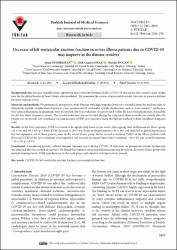| dc.contributor.author | Demirkiran, Aykut | |
| dc.contributor.author | Onar, L. Ç. | |
| dc.contributor.author | Doğan, Mustafa | |
| dc.date.accessioned | 2022-05-11T14:05:00Z | |
| dc.date.available | 2022-05-11T14:05:00Z | |
| dc.date.issued | 2021 | |
| dc.identifier.issn | 1300-0144 | |
| dc.identifier.uri | https://doi.org/10.3906/sag-2101-198 | |
| dc.identifier.uri | https://hdl.handle.net/20.500.11776/4866 | |
| dc.description.abstract | Background/aim: Increase in publications supporting myocardial involvement in the COVID-19 disease has led to need to gain insight into the the global burden of heart failure after pandemic. We examined the course of myocardial systolic function in patients without elevated troponin levels. Materials and methods: We performed a prospective study. Patients with high troponin levels were excluded from the study in order to definitively exclude complications known to cause permanent left ventricular systolic dysfunction, such as acute coronary syndromes. Two echocardiographic examinations were performed. The first evaluation was performed within the days of hospitalization, if possible, on the day when dyspnea is severe. The second evaluation was performed during the outpatient clinic controls one month after the patient was recovered. Left ventricular ejection fraction (LVEF) was measured using the biplane method of disks (modified Simpson’s rule). Results: In the first evaluation, LVEF was found to be significantly lower in the severe illness group than mild/moderate illness group (50 ± 6% and 59 ± 6%; p = 0.03). LVEF decrease (<50%) was found in fifteen patients (43 ± 4%) and detected as global hypokinesia but not segmental. All of these patients were in the severe illness group. In the second evaluation, LVEFs of the fifteen patients with decreased LVEF in the first evaluation were improved and detected in normal limits (first evaluation = 43 ± 4% and second evaluation = 55 ± 2%, p = 0.01). Conclusion: Considering patients without elevated troponin levels during COVID-19 infection, no permanent systolic dysfunction was detected after first month of recovery. We found that transient myocardial dysfunction may develop in the severe illness group with normal troponin levels, LVEF may decrease in the acute phase and improve with the recovery period. © TÜBİTAK. | en_US |
| dc.description.sponsorship | We appreciate Tekirda? Provincial Health Director Ali Cengiz Kalkan for providing support and thank Dr. Hasan De?irmenci and Dr. Ulugbin Hayri for their contribution in the examination of the patients.Funding This study was funded by Aykut Demirk?ran, Hasan De?irmenci, and Ulug Bey Hayri. The study protocol received institutional review board approval. All participants provided informed consent. | en_US |
| dc.language.iso | eng | en_US |
| dc.publisher | Turkiye Klinikleri | en_US |
| dc.identifier.doi | 10.3906/sag-2101-198 | |
| dc.rights | info:eu-repo/semantics/openAccess | en_US |
| dc.subject | COVID-19 | en_US |
| dc.subject | Left ventricular ejection fraction | en_US |
| dc.subject | Myocardial dysfunction | en_US |
| dc.subject | troponin | en_US |
| dc.subject | adult | en_US |
| dc.subject | blood | en_US |
| dc.subject | complication | en_US |
| dc.subject | diagnosis | en_US |
| dc.subject | diagnostic imaging | en_US |
| dc.subject | echocardiography | en_US |
| dc.subject | female | en_US |
| dc.subject | genetics | en_US |
| dc.subject | heart left ventricle function | en_US |
| dc.subject | heart stroke volume | en_US |
| dc.subject | human | en_US |
| dc.subject | isolation and purification | en_US |
| dc.subject | male | en_US |
| dc.subject | middle aged | en_US |
| dc.subject | physiology | en_US |
| dc.subject | prospective study | en_US |
| dc.subject | reverse transcription polymerase chain reaction | en_US |
| dc.subject | severity of illness index | en_US |
| dc.subject | Adult | en_US |
| dc.subject | COVID-19 | en_US |
| dc.subject | Echocardiography | en_US |
| dc.subject | Female | en_US |
| dc.subject | Humans | en_US |
| dc.subject | Male | en_US |
| dc.subject | Middle Aged | en_US |
| dc.subject | Prospective Studies | en_US |
| dc.subject | Reverse Transcriptase Polymerase Chain Reaction | en_US |
| dc.subject | SARS-CoV-2 | en_US |
| dc.subject | Severity of Illness Index | en_US |
| dc.subject | Stroke Volume | en_US |
| dc.subject | Troponin | en_US |
| dc.subject | Ventricular Dysfunction, Left | en_US |
| dc.subject | Ventricular Function, Left | en_US |
| dc.title | Decrease of left ventricular ejection fraction in severe illness patients due to COVID-19 may improve as the disease resolves | en_US |
| dc.type | article | en_US |
| dc.relation.ispartof | Turkish Journal of Medical Sciences | en_US |
| dc.department | Fakülteler, Tıp Fakültesi, Dahili Tıp Bilimleri Bölümü, Enfeksiyon Hastalıkları Ana Bilim Dalı | en_US |
| dc.identifier.volume | 51 | en_US |
| dc.identifier.issue | 6 | en_US |
| dc.identifier.startpage | 2861 | en_US |
| dc.identifier.endpage | 2869 | en_US |
| dc.institutionauthor | Doğan, Mustafa | |
| dc.relation.publicationcategory | Makale - Uluslararası Hakemli Dergi - Kurum Öğretim Elemanı | en_US |
| dc.authorscopusid | 35195470300 | |
| dc.authorscopusid | 55765181800 | |
| dc.authorscopusid | 57196589837 | |
| dc.identifier.wos | WOS:000731456300007 | en_US |
| dc.identifier.scopus | 2-s2.0-85122903562 | en_US |
| dc.identifier.pmid | 34493031 | en_US |



















